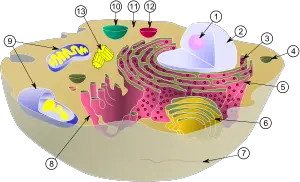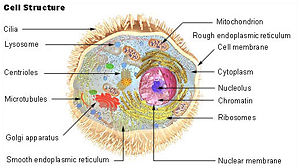Difference between revisions of "Cytoplasm" - New World Encyclopedia
Rick Swarts (talk | contribs) |
Rick Swarts (talk | contribs) |
||
| Line 1: | Line 1: | ||
{{Contracted}} | {{Contracted}} | ||
[[Image:Illu cell structure.jpg|thumb|300px|[[Organelles]]. Cytoplasm labeled at center right.]] | [[Image:Illu cell structure.jpg|thumb|300px|[[Organelles]]. Cytoplasm labeled at center right.]] | ||
| − | [[Image:Biological cell.svg|thumb|300px|Schematic of typical [[animal]] [[cell (biology)|cell]], showing subcellular components. Organelles: (1) [[nucleolus]] (2) [[cell nucleus|nucleus]] (3) [[ribosome]] (4) vesicle (5) rough [[endoplasmic reticulum]] (ER) (6) [[Golgi apparatus]] (7) [[Cytoskeleton]] (8) smooth ER (9) [[mitochondrion|mitochondria]] (10) vacuole (11) [[ | + | [[Image:Biological cell.svg|thumb|300px|Schematic of typical [[animal]] [[cell (biology)|cell]], showing subcellular components. Organelles: (1) [[nucleolus]] (2) [[cell nucleus|nucleus]] (3) [[ribosome]] (4) vesicle (5) rough [[endoplasmic reticulum]] (ER) (6) [[Golgi apparatus]] (7) [[Cytoskeleton]] (8) smooth ER (9) [[mitochondrion|mitochondria]] (10) vacuole (11) [[cytosole]] (12) [[lysosome]] (13) [[centriole]]s]] |
| − | '''Cytoplasm''' is the portion of a [[Cell (biology)|cell]] that is inside the [[cell membrane]], but does not include the nucleus or nuclear membrane in [[eukaryote]]s. | + | '''Cytoplasm''' is the portion of a [[Cell (biology)|cell]] that is inside the [[cell membrane]], but does not include the nucleus or nuclear membrane in [[eukaryote]]s. It is sometimes used synonymously with the fluid that is not compartimentalized into organelles (membrane-bounded, distinct compartments), but is used here in its broad sense as including the organelles. |
In [[prokaryote]]s, the cytoplasm fills the inside of the cell, with the genetic material and ribosomes floating freely in the cytoplasm. | In [[prokaryote]]s, the cytoplasm fills the inside of the cell, with the genetic material and ribosomes floating freely in the cytoplasm. | ||
| − | In eukaryotes, the cytoplasm lies between the nuclear membrane and the cell membrane. It is | + | In eukaryotes, the cytoplasm is that portion of the cell that lies between the nuclear envelope (nuclear membrane) and the cell membrane. It is comprised of the [[cytosol]] (fluid-filled space outside the organelles) and the cellular organelles floating in the cytosol (Alberts et al. 1989). The cytosol is made up of water, salts, organic [[molecule]]s, and many [[enzyme]]s that catalyze reactions. Organelles in the cytoplasm include [[mitochondrion|mitochondria]], [[chloroplast]]s (in [[plant]]s), [[endoplasmic reticulum]] (ER) (rough and smooth ER), golgi apparatus, lysosomes, endosomes, and peroxisomes (Alberts et al. 1989). Each type of organelle has its own distinct function, enzymes, and other specialized molecules, |
| − | The cytoplasm | + | ==Function== |
| + | The cytoplasm holds all of the cellular organelles outside of the nucleus and also maintains the shape and consistency of the cell. It is also a storage place for chemical substances indispensable to [[life]], which are involved in vital [[metabolism|metabolic]] reactions, such as anaerobic [[glycolysis]] and [[protein]] [[synthesis]]. | ||
| − | + | The cytosol, which is that portion of the cytoplasm that occupies the intracellular space outside the membrane-bounded organelles, is the site of protein synthesis and most of the cells intermediary metabolism (Alberts et al. 1989). It has thousands of [[enzymes]] involved in metabolism (Alberts et al. 1989). Many of the newly synthesized proteins remain in the cytosol—about half according to Alberts et al. (1989)—if they lack a signal for transport. The cytosol also plays an important role in a cell by serving as a "molecular chowder" in which the organelles are suspended and held together by a fatty membrane. | |
| − | The cytoplasm | ||
| − | In bacteria, | + | In [[bacteria]], chemical reactions take place in the cytoplasm and all of the genetic material is suspended in the cytoplasm. |
==Components of the cytoplasm== | ==Components of the cytoplasm== | ||
| − | The cytoplasm is composed of [[ion]]s and soluble [[macromolecule]]s like [[enzyme]]s, [[carbohydrate]]s, different [[salt]]s and [[protein]]s, as well as a great proportion of [[RNA | + | The cytoplasm is composed of [[ion]]s and soluble [[macromolecule]]s like [[enzyme]]s, [[carbohydrate]]s, different [[salt]]s, and [[protein]]s, as well as a great proportion of [[RNA]]. |
| − | It can be more or less [[water]]-like or liquid depending on the milieu's conditions and the activity phases of the cell. In the | + | The cytoplasm's watery component is also known as hyaloplasm. It can be more or less [[water]]-like or liquid depending on the milieu's conditions and the activity phases of the cell. In the case of being a viscous solid mass, it may be referred to as cytogel. In the more liquid case, it is called [[cytosol]]. In general, margin regions of the cell are water-like. |
The [[organelle]]s (such as the [[mitochondria]], the [[chloroplast]], [[lysosome]]s, [[peroxysome]]s, [[ribosome]]s, [[vacuole]]s, [[cytoskeleton]]s, and complex [[cell membrane]] structures like the [[endoplasmic reticulum]]s) in the cytoplasm are insoluble. | The [[organelle]]s (such as the [[mitochondria]], the [[chloroplast]], [[lysosome]]s, [[peroxysome]]s, [[ribosome]]s, [[vacuole]]s, [[cytoskeleton]]s, and complex [[cell membrane]] structures like the [[endoplasmic reticulum]]s) in the cytoplasm are insoluble. | ||
| − | + | While all cells possess cytoplasm, cells from different biological domains can differ widely in the characteristics of their cytoplasms. In the [[animal kingdom]], cytoplasm occupies nearly half the cell's volume, while in plant cells, the cytoplasm occupies much less space because of the presence of [[vacuoles]]. | |
| − | While all cells possess cytoplasm, cells from different | ||
Revision as of 20:32, 9 February 2007

Cytoplasm is the portion of a cell that is inside the cell membrane, but does not include the nucleus or nuclear membrane in eukaryotes. It is sometimes used synonymously with the fluid that is not compartimentalized into organelles (membrane-bounded, distinct compartments), but is used here in its broad sense as including the organelles.
In prokaryotes, the cytoplasm fills the inside of the cell, with the genetic material and ribosomes floating freely in the cytoplasm.
In eukaryotes, the cytoplasm is that portion of the cell that lies between the nuclear envelope (nuclear membrane) and the cell membrane. It is comprised of the cytosol (fluid-filled space outside the organelles) and the cellular organelles floating in the cytosol (Alberts et al. 1989). The cytosol is made up of water, salts, organic molecules, and many enzymes that catalyze reactions. Organelles in the cytoplasm include mitochondria, chloroplasts (in plants), endoplasmic reticulum (ER) (rough and smooth ER), golgi apparatus, lysosomes, endosomes, and peroxisomes (Alberts et al. 1989). Each type of organelle has its own distinct function, enzymes, and other specialized molecules,
Function
The cytoplasm holds all of the cellular organelles outside of the nucleus and also maintains the shape and consistency of the cell. It is also a storage place for chemical substances indispensable to life, which are involved in vital metabolic reactions, such as anaerobic glycolysis and protein synthesis.
The cytosol, which is that portion of the cytoplasm that occupies the intracellular space outside the membrane-bounded organelles, is the site of protein synthesis and most of the cells intermediary metabolism (Alberts et al. 1989). It has thousands of enzymes involved in metabolism (Alberts et al. 1989). Many of the newly synthesized proteins remain in the cytosol—about half according to Alberts et al. (1989)—if they lack a signal for transport. The cytosol also plays an important role in a cell by serving as a "molecular chowder" in which the organelles are suspended and held together by a fatty membrane.
In bacteria, chemical reactions take place in the cytoplasm and all of the genetic material is suspended in the cytoplasm.
Components of the cytoplasm
The cytoplasm is composed of ions and soluble macromolecules like enzymes, carbohydrates, different salts, and proteins, as well as a great proportion of RNA.
The cytoplasm's watery component is also known as hyaloplasm. It can be more or less water-like or liquid depending on the milieu's conditions and the activity phases of the cell. In the case of being a viscous solid mass, it may be referred to as cytogel. In the more liquid case, it is called cytosol. In general, margin regions of the cell are water-like.
The organelles (such as the mitochondria, the chloroplast, lysosomes, peroxysomes, ribosomes, vacuoles, cytoskeletons, and complex cell membrane structures like the endoplasmic reticulums) in the cytoplasm are insoluble.
While all cells possess cytoplasm, cells from different biological domains can differ widely in the characteristics of their cytoplasms. In the animal kingdom, cytoplasm occupies nearly half the cell's volume, while in plant cells, the cytoplasm occupies much less space because of the presence of vacuoles.
| Organelles of the cell |
|---|
| Acrosome | Chloroplast | Cilium/Flagellum | Centriole | Endoplasmic reticulum | Golgi apparatus | Lysosome | Melanosome | Mitochondrion | Myofibril | Nucleus | Parenthesome | Peroxisome | Plastid | Ribosome | Vacuole | Vesicle |
Credits
New World Encyclopedia writers and editors rewrote and completed the Wikipedia article in accordance with New World Encyclopedia standards. This article abides by terms of the Creative Commons CC-by-sa 3.0 License (CC-by-sa), which may be used and disseminated with proper attribution. Credit is due under the terms of this license that can reference both the New World Encyclopedia contributors and the selfless volunteer contributors of the Wikimedia Foundation. To cite this article click here for a list of acceptable citing formats.The history of earlier contributions by wikipedians is accessible to researchers here:
The history of this article since it was imported to New World Encyclopedia:
Note: Some restrictions may apply to use of individual images which are separately licensed.
